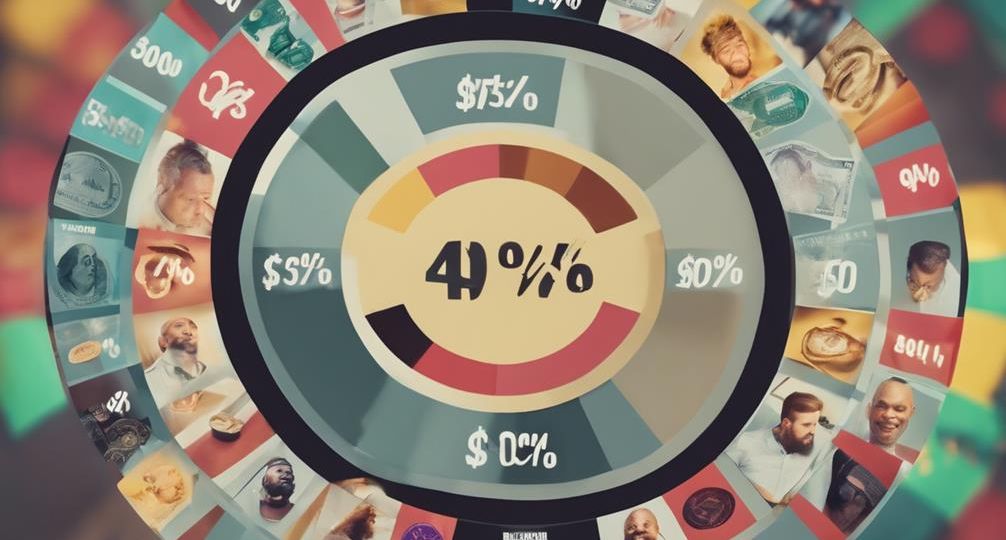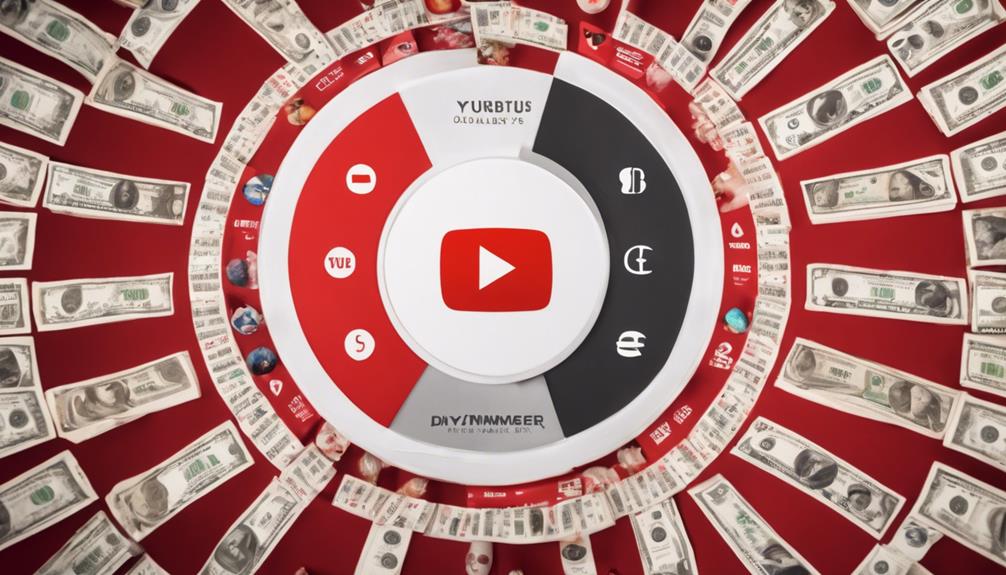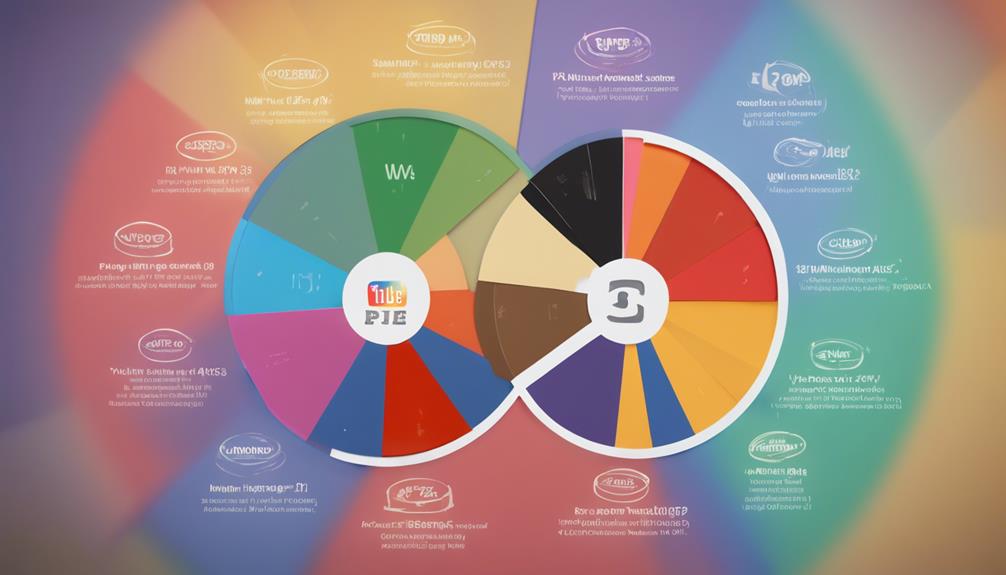
What percentage of YouTubers make money?
Despite the popular belief that everyone on YouTube is raking in big bucks, the reality might surprise you.
Ever wondered about the exact percentage of YouTubers who actually make money? The answer isn’t as straightforward as you may think, and it’s not just about the number of subscribers or views.
Factors such as engagement, content quality, and monetization strategies also play a significant role.
Stick around, as we’re about to unpack these nuances and more.
Key Takeaways
- A small percentage of YouTube creators actually turn a profit due to factors like production costs and viewer engagement.
- YouTube’s revenue model involves content, algorithm influence, and video optimization, making earnings unpredictable.
- Diversified monetization strategies including brand partnerships, crowdfunding, and merchandise sales are crucial for YouTubers’ earnings.
- High earning YouTubers are primarily male in the 18-34 age group, with content niches in gaming, beauty, tech, and comedy leading in revenue.
Understanding YouTube’s Revenue Model

To fully grasp how YouTubers make money, it’s imperative to first understand YouTube’s complex revenue model. You see, it’s not just a platform for sharing videos; it’s a sophisticated ecosystem where content, algorithm influence, and video optimization intertwine.
In this model, algorithm influence plays a pivotal role. YouTube’s algorithms decide which videos appear in search results, suggested feeds, and trending lists. They prioritize videos that engage viewers for longer durations, creating a competitive landscape where ‘watch time’ is king. No matter how great your content is, if the algorithm doesn’t favor it, your earning potential diminishes.
That’s where video optimization comes in. It’s an innovative technique for making your videos more appealing to YouTube’s algorithms. By carefully selecting your video’s title, description, tags, and even thumbnail, you increase your chances of getting noticed by the algorithm. It’s a strategic move that pays off in terms of views, subscribers, and ultimately, revenue.
This intricate dance between algorithm influence and video optimization forms the core of YouTube’s revenue model. Understanding this dynamic is crucial for anyone seeking to monetize their YouTube presence successfully. Remember, in this digital arena, being innovative isn’t just desirable; it’s necessary.
The Role of AdSense in Earnings
Having grasped the concept of algorithm influence and video optimization, you’ll now appreciate how crucial AdSense plays into the earnings of a YouTuber. This ad serving system allows you to earn money from your videos through ad revenue. When you’re eligible for AdSense, it becomes a significant source of income.
However, achieving AdSense eligibility can be a hurdle. You need to meet YouTube’s criteria, involving a minimum number of subscribers and watch hours. Plus, your content must align with YouTube’s community guidelines, advertising policies, and copyright laws.
There’s also the option of AdSense alternatives, which can provide another revenue stream. These alternatives may offer more flexibility or better suitability to your content and audience demographics. Let’s dive into a few examples:
- Patreon: A platform where your fans can support you financially on a monthly basis.
- Affiliate marketing: You can earn commissions by promoting products or services.
- Merchandising: Selling your own products or merchandise related to your channel.
In essence, AdSense plays a pivotal role, but it’s not the sole player. By diversifying your income sources, you can maximize the earning potential of your YouTube channel.
Number of YouTubers Earning Money

You might be wondering just how many YouTubers are actually making money.
To truly grasp this, it’s essential to first understand the concept of YouTube monetization and the stark reality of YouTube earnings.
From there, we can analyze the success of money-making channels, shedding light on the percentage of YouTubers who are indeed profitable.
Understanding YouTube Monetization
Diving into the world of YouTube monetization, it’s vital to grasp just how many content creators are actually making money from this platform. It’s not as simple as uploading a video and watching the dollars roll in. A clear content strategy and video optimization are key.
Understanding YouTube monetization entails knowing:
- The significance of video optimization in attracting views and consequently, ad revenue.
- The role of a consistent, engaging content strategy in building and retaining an audience.
- The importance of subscriber count and watch time in determining ad revenue potential.
Innovation is the name of the game, and in YouTube’s ever-evolving landscape, you’ve got to stay ahead. Harness the power of your creativity, backed by a solid understanding of monetization, to carve out your own slice of the YouTube profit pie.
Reality of YouTube Earnings
Despite the allure of YouTube earnings, the hard truth is that only a small fraction of content creators actually turn a profit on this platform. You need to consider video production costs, which can be hefty, and the unpredictable nature of viewer engagement.
Influencer marketing can boost your revenue, but it’s not guaranteed or consistent. It’s a common misconception that getting thousands of views equates to a substantial income. The reality is, ad revenue is often meager, and without a significant subscriber base, it’s challenging to secure profitable brand partnerships.
Furthermore, YouTube’s algorithm can be a wild card, impacting your visibility and earnings potential. It’s clear that making money on YouTube isn’t as straightforward as it’s often portrayed.
Successful Money-Making Channels
Though the path to profit is steep, a small percentage of YouTube channels have indeed achieved financial success, managing to carve out substantial earnings in the competitive digital landscape. Channel branding and the creation of viral content play crucial roles in this success.
- Channel Branding: It’s crucial to establish a unique, recognizable identity that resonates with your target audience. Your brand should be consistent across all videos and social media platforms, creating a cohesive image that viewers can associate with your content.
- Viral Content: This refers to videos that gain popularity rapidly and are shared extensively across various platforms. They significantly increase visibility, thereby boosting revenue.
- Engagement: Engaging with your audience helps build a loyal fanbase, which can increase views, shares, and likes – all essential for monetization.
Breaking Down YouTube’s Partner Program

Let’s break down YouTube’s Partner Program, starting with its monetization criteria. To become eligible for earnings, you must meet specific requirements that YouTube sets.
Understanding these criteria, as well as how potential earnings are calculated, can provide a clearer picture of the financial landscape for YouTubers.
YouTube’s Monetization Criteria
Understanding the intricacies of YouTube’s Partner Program can be crucial in your journey as a content creator, as it sets the groundwork for monetization on the platform. You need to be aware of the eligibility requirements and avoid policy violations to ensure a smooth monetization process.
- Eligibility Requirements: To qualify for monetization, you must live in a country where the YouTube Partner Program is available, have more than 4,000 valid public watch hours in the last 12 months, have more than 1,000 subscribers, and have a linked AdSense account.
- Policy Violations: YouTube has strict policies against copyright infringement, harmful or dangerous content, and hateful conduct. Repeated violations can lead to channel demonetization.
- Channel Review: After meeting the requirements and adhering to YouTube’s policies, your channel is reviewed before it can be monetized.
Potential Earnings Breakdown
Now that you’re familiar with YouTube’s eligibility requirements and policy guidelines, we can start to analyze the financial aspects of the YouTube Partner Program. Earnings Transparency is at the core of understanding potential revenue. Let’s break it down:
| Revenue Source | Percentage | Potential Earnings |
|---|---|---|
| Ad Revenue | 55% | Varies |
| Channel Memberships | 70% | Up to $5/member |
| Super Chat | 70% | Varies |
| YouTube Premium | Varies | Varies |
| Merch Shelf | 70% | Varies |
These figures are estimates, as actual earnings can fluctuate. Now, Platform Alternatives like Twitch or Patreon offer similar revenue models, with different percentages. By comparing these, you can strategically choose the best platform for your content and maximize your earning potential.
High Earning YouTuber Demographics
A significant proportion of high-earning YouTubers share certain demographic characteristics that provide insightful patterns into the lucrative world of online video content creation. This demographic breakdown reveals key trends associated with gender disparity and content type.
Firstly, gender disparity is a noteworthy aspect. There’s a higher percentage of male YouTubers in the high earning category. Despite this, a growing number of successful female YouTubers are bridging the gap, demonstrating that success isn’t gender-exclusive.
Secondly, content type plays a pivotal role. Certain genres tend to generate more revenue, with gaming, beauty and lifestyle, tech reviews, and comedy leading the pack.
Let’s examine these trends in detail:
- Gender Disparity: Men currently dominate the high-earning YouTuber scene, but the rise of successful female creators is shifting the balance, bringing fresh perspectives and diversity to the platform.
- Content Type: Gaming, beauty, and tech-related content are proven money-makers. However, innovative content outside these genres can also achieve high earnings, highlighting the platform’s potential for creative diversity.
- Age Group: Most high-earning YouTubers fall into the 18-34 age range, reflecting the primary demographic of YouTube’s user base and the age group most likely to engage with content monetization strategies.
These trends underline the dynamic and evolving nature of YouTube’s economic ecosystem.
Factors Influencing YouTuber Earnings

You should understand that YouTuber earnings aren’t purely based on luck or the roll of a dice.
It’s essential to consider monetization strategies and the impact of audience engagement as significant factors.
They can notably alter the monetary landscape for content creators on this platform.
Monetization Strategies
While it’s clear that not every YouTuber is raking in cash, understanding the factors influencing earnings can help illuminate the strategies successful creators are using to monetize their content. Brand collaborations and crowdfunding strategies are two key components in this equation.
You see, brand collaborations are all about leveraging your audience for mutual benefit. Brands are always on the lookout for influencers who can authentically promote their products to a receptive audience. As for crowdfunding strategies, they let your viewers directly finance your content. Platforms like Patreon have become popular for this purpose.
Consider these tactics:
- Seeking out brand partnerships that align with your content and audience.
- Launching a crowdfunding campaign to fund specific projects or ongoing content creation.
- Exploring other monetization methods such as merchandise sales or paid memberships.
Each of these strategies requires careful planning, but they can significantly boost your YouTube earnings.
Audience Engagement Impact
Beyond the realm of brand partnerships and crowdfunding, audience engagement plays a pivotal role in determining a YouTuber’s earnings. As a content creator, understanding your engagement analytics is crucial. These analytics provide insights into how viewers interact with your content, ultimately affecting your income.
Keeping up with viral trends is another key factor. It’s not just about the views; it’s about sparking conversations, increasing shares, and accruing likes. This heightened interaction boosts your visibility, which can, in turn, increase earnings.
Consider the table below:
| Engagement Metrics | Impact on Earnings |
|---|---|
| Likes and Comments | Directly affects YouTube’s algorithm, leading to increased visibility and potential ad revenue |
| Shares | Expands reach beyond your existing audience, potentially leading to more subscribers and ad revenue |
| Viral Trends Participation | Attracts views and engagement, potentially leading to increased earnings |
| High Retention Rate | Indicates high-quality content, potentially leading to more partnerships and sponsorships |
Case Study: Successful YouTubers
Diving into the realm of successful YouTubers, it’s clear that a significant percentage have managed to monetize their channels effectively. Their success can often be attributed to two key strategies: clever influencer branding and a well-chosen content niche.
Influencer branding is about creating a unique and identifiable persona. This persona becomes the face of the channel, making it easily recognizable and relatable. Successful YouTubers understand that the more distinctive their persona, the more memorable they become to their viewers.
Choosing a content niche is equally important. It’s about finding a specific topic or area that resonates with a particular audience. The more specialized the niche, the more targeted and engaged the audience.
Let’s look at three brief case studies:
- PewDiePie: Known for his comedic and often outrageous commentaries on video games. His unique persona and specific niche have earned him millions of loyal followers.
- Jeffree Star: His channel is focused on beauty and makeup reviews. His flamboyant persona and expertise in the beauty niche have made him a YouTube sensation.
- Vsauce: A channel dedicated to answering peculiar questions, providing intriguing facts, and exploring scientific theories. The host’s charismatic persona and the niche of educational entertainment have attracted a vast audience.
The Impact of Subscriber Count

Unraveling the intricacies of subscriber count, it’s important to realize the profound impact it has on a YouTuber’s income potential. The raw numerical value of your subscribers isn’t all that matters. It’s the quality, not just the quantity, that’s crucial.
Take subscriber attrition into account, for instance. This refers to the rate at which you lose subscribers over time. A high attrition rate can significantly impact your income potential. If you’re losing subscribers faster than you’re gaining them, your revenue stream may suffer. So, it’s not just about getting people to hit the subscribe button, it’s about keeping them engaged and invested in your content.
Then, there are the engagement algorithms. YouTube’s algorithm takes into account not just the number of subscribers, but also how engaged those subscribers are. This includes factors like how many of your videos they watch, how long they watch them for, and whether they like, comment, or share. Undeniably, a highly engaged audience boosts your visibility on YouTube, ultimately leading to increased ad revenue.
Sponsorships and Affiliate Marketing
While keeping your audience engaged is crucial, another viable income stream you can tap into as a YouTuber comes from sponsorships and affiliate marketing. This method isn’t just about promoting a product; it’s about creating a meaningful connection between your content, the product, and your audience.
Influencer collaborations and brand partnerships offer a wealth of opportunities. You can leverage these to grow your channel, enhance your content, and generate revenue. Here’s how:
- Influencer Collaborations: By teaming up with fellow YouTubers or influencers in your niche, you can cross-promote each other’s channels or products. This expands your reach and provides fresh content for your audience.
- Brand Partnerships: Working with brands directly can lead to sponsorships. These deals often involve creating content featuring the brand’s product or service. In return, you’ll receive compensation, which can significantly boost your income.
- Affiliate Marketing: By including affiliate links in your video descriptions, you can earn a commission on any sales made through your link. This is a straightforward way to monetize your content without affecting your audience’s viewing experience.
YouTube’s Premium and Membership Features

Often overlooked, YouTube’s Premium and Membership features present another practical avenue for content creators to monetize their channels. As a creator, you can offer Premium exclusives for your subscribers who opt for an ad-free experience. This innovative feature allows you to present exclusive content, like unreleased videos or behind-the-scenes footage, and in turn, generates additional revenue.
Moreover, the Membership perks are a game-changer. By creating various membership tiers, you’re able to provide numerous perks to your loyal subscribers. Ranging from custom emojis to exclusive live chats, these features enhance the viewer’s experience and foster a strong community around your channel. It’s not just about generating income; it’s about deepening the connection with your audience.
Understanding and leveraging these features can significantly increase your revenue. They’re not just tools for monetization but also for enhancing viewer engagement. Remember, in the world of YouTube, innovation is key. The more you harness these features, the more you stand out, and ultimately, the more profitable your channel becomes. So, don’t just rely on ad revenue. Be smart, embrace the Premium and Membership features, and watch your profits rise.
Diversifying Income: Merchandise and Events
In addition to leveraging YouTube’s Premium and Membership features, you can also expand your revenue streams by selling merchandise related to your channel and hosting events for your followers. This strategy works particularly well for channels with a dedicated fan base. By offering unique merchandise, you not only provide your fans with tangible expressions of their support but also create an additional income source.
Consider these three aspects when planning your merchandise strategy:
- Design and Quality: Ensure your merchandise reflects your brand identity and maintains a high-quality standard. Your fans won’t appreciate shoddy products.
- Brand Collaborations: Partnering with established brands can boost your merchandise’s visibility and credibility. This is where the power of influencer marketing shines.
- Distribution and Logistics: You’ll need a reliable system for delivering your merchandise to fans worldwide. Choose your partners wisely.
Hosting events is another effective way to diversify your revenue. These can range from meet-and-greets to larger conventions or festivals. By charging for tickets or sponsorships, you can monetize your influence while strengthening your connection with your audience. Remember, innovation and engagement are key to your success in these ventures.
Future Predictions for YouTube Earnings

Looking ahead, it’s clear that the landscape of YouTube earnings is poised for some significant changes, and it’s crucial to understand what these shifts might mean for your YouTube career.
Influencer partnerships are likely to become an increasingly crucial part of the earning equation. As brands recognize the power and reach of these influencers, they’re investing heavily in such collaborations, creating new earnings opportunities.
Viewer demographics, too, will play a pivotal role in shaping future YouTube earnings. The younger generation is increasingly dominating the viewership, and their preferences will dictate the content types and advertising strategies. They’re drawn to authenticity and diversity, and successful YouTubers will tap into these trends.
Moreover, innovations in technology will also impact earnings. Expect to see increased integration of virtual and augmented reality, offering more immersive experiences and thus potentially higher viewer engagement.

